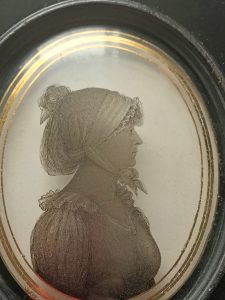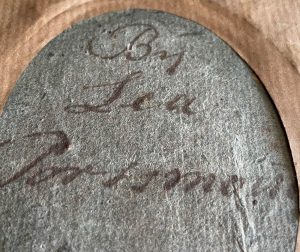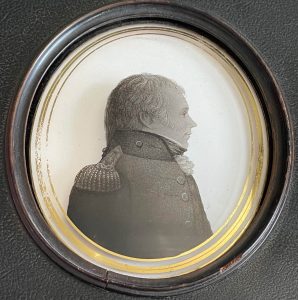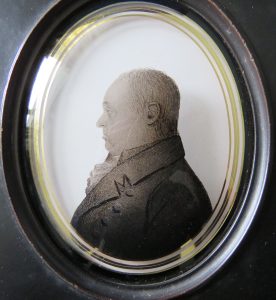Lea of Portsmouth – a new identity

© Private Collection
Lea’s profiles are prized by collectors not just for their distinctive and appealing style but also for their comparative rarity. Carefully painted on the underside of convex glass in shades of translucent grey, they always show the sitter’s facial features and costume details using a combination of fine stippling, short brushstrokes and scratching out. His profiles are typically finished with three narrow verre églomisé borders in gold, then backed with plaster and housed in papier-mâché frames. Lea did not use a printed trade label but some works were signed on the blue backing paper ‘Lea, Portsmouth’.

Being a naval base and a garrison town, Portsmouth guaranteed Lea a steady clientele of officers seeking portraits to send home as mementoes. Each portrait would have taken many hours of painstaking work so perhaps it is no surprise that Lea’s output was limited.

© Private Collection
Owing to what is now recognised to have been a mis-read inscription on the back of one of his silhouettes, Lea’s first name has traditionally been recorded as ‘Arthur’. Fresh research has, however, now proved that his first name was actually John.
John Lea was born in early 1768 – probably in Portsmouth – though no confirmed record of his birth has been traced. At the age of 21 in June 1790, he married a local girl, Elizabeth Nelson, at St Thomas’s (now the Anglican cathedral). The marriage index lists him as a ‘gent’. The young couple settled to live at Grand Parade in Portsmouth, a central and prestigious address and, between 1791 and 1809, had four sons and five daughters, though three children did not survive infancy.
The lack of a printed trade label suggests that painting silhouettes was not John Lea’s primary source of income and this is borne out by the Universal British Directory for 1792 that lists amongst the residents of Portsmouth ‘John Lea, glazier’. He was not the only artist from the period to have traded as a glazier and chosen to paint silhouettes on glass, John Woodhouse of Newcastle being another example. The trade would have given them ready access to suitable glass and both men may have honed their painting skills on stained glass projects.

© Private Collection
At some point John and Elizabeth became members of the Non-Conformist Church, perhaps swept up by the fervour surrounding the newly opened independent King Street Chapel in nearby Portsea in 1813. In November of that year they had their three youngest children baptised there – James would have been eleven, Mary Ann eight and Eliza four years old.
The next major event in the Leas’ family life was a move to London which occurred some time between 1814 and 1823. The reason for uprooting the family is hard to fathom as neither John nor Elizabeth appear to have had family connections in London. Perhaps John had acquired a patron for his art who persuaded him to make the move to further his artistic career. Their new home was 6 Great Charlotte Street off Blackfriars Road. It was from this address that John Lea exhibited a portrait (undoubtedly one of his silhouettes) of the Non-conformist preacher Rev. J. Angel James at the Royal Academy. It must have been a great coup for Lea to have seen his work hung alongside miniatures by the likes of George Engleheart and Andrew Robertson.
The final official record for John Lea is the notice in the Hampshire Telegraph (3 March 1828) that announced his death at the age of sixty ‘leaving a wife and several children’. The obituary gives an insight to his personality making mention of his
superior natural intelligence – his various knowledge – his conversational talents – his unaffected piety and the active benevolence of his character . . .
The same newspaper announced his wife’s death in 1842 –
at her residence in London, Mrs Elizabeth Lea, relict of Mr John Lea, artist, formerly of the Grand Parade, Portsmouth in her 77th year. Her end was peace.
Lea was an accomplished artist and it is satisfying to have uncovered his true identity and to now know more of his life story.